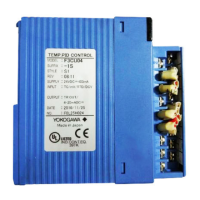A2-9
IM 34M06H62-02E 3rd Edition : Jul.16
2015-00
Table A2.7 Function List (2/2)
Category
Functions Description
Control and computation
Set point
Set points
Four set points can be predefined for each loop. A predefined set point can be selected using the
SP number parameter.
Remote set point Can be used to continually change the set point value from the CPU module or by other means.
SP tracking Retains the set point value when switching from remote to local mode.
SP limiter Limits the set point within specified limits in remote or cascade control mode.
SP gradient
setting
Defines acceleration and deceleration independently for varying the control set point at a fixed rate
or to prevent an abrupt change in the control set point.
PV tracking
When a switchover is made from Stop to Run, from Manual to Automatic, or from one SP number to
another, the control set point is first set to the current PV value and then gradually changed to the
required value at the rate defined by the SP gradient parameters.
Auto-
tuning
Dynamic
auto-tuning
Automatically recalculates PID constants to achieve continuous stable control at the beginning of a
control operation or when control becomes unstable.
Auto-tuning
When a start tuning instruction is issued, measures the characteristics of a control object by
switching on and then switching off the output, and automatically determines and sets optimal PID
constants.
Control
and
compu-
tation
Forward/reverse
operation
Defines the direction of output change (increase or decrease) corresponding to a positive deviation.
PID control mode
The combination of the CMD parameter (0: standard PID control mode, 1: fixed-point control mode)
and the remote/local switch determines the PID control method (PV derivative type PID control or
deviation derivative type PID control) with or without bumping.
Super Suppresses overshooting using fuzzy logic.
Anti-reset windup
Prevents excessive integration and hence overshooting by suspending PID computation. The
deviation width for resuming PID computation can be set using a parameter.
PID selection Selects one of the four PID parameter groups belonging to each loop.
PID
selection
method
SP number
selection
Switches between four PID parameter groups according to the value of the SP Number Selection
parameter.
Zone PID selection
Automatically switches between PID parameter groups according to PV value. In addition, allows
switching to a specific PID parameter group when the deviation is large.
Operation control Switches between run/stop, automatic/manual/cascade, remote/local, and other operating modes.
Alarm
Alarm
Alarm setup
Defines four alarms for each loop. Alarms may be defined to trigger with respect to the upper or
lower input limit or differential upper or lower limit.
Waiting Suppresses alarms during the startup period after power on until the operation stabilizes.
Delay timer Reports an alarm only if an alarm condition persists for a minimum duration.
Backup function
(Storing of preset values)
Stores parameters to the EEPROM, which is writable up to 100,000 times.

